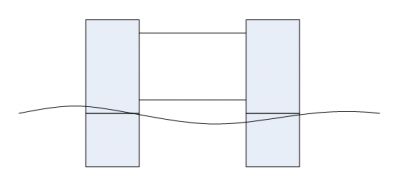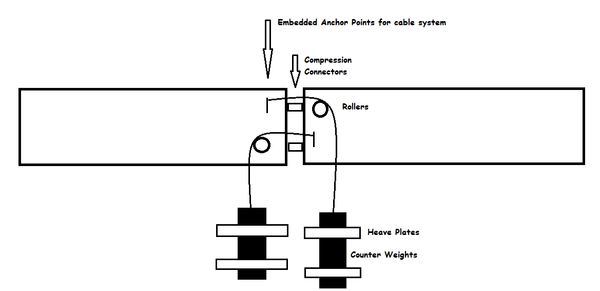Difference between revisions of "Connections"
Thebastidge (talk | contribs) (→Flexibility) |
Thebastidge (talk | contribs) (→Logistics) |
||
| Line 3: | Line 3: | ||
==Logistics== | ==Logistics== | ||
| − | On might argue that for small scale seasteads, connections are a logistical necessity. When on a big seastead with hundreds of inhabitants, one might stay on the same seastead for days on end. But when living on a seastead which is either an independent house, or a few of them, getting out of the house is likely to be something you would want to do multiple times a day. Transferring between vessels in the open ocean is hard to impossible, depending on the weather outside | + | On might argue that for small scale seasteads, connections are a logistical necessity. When on a big seastead with hundreds of inhabitants, one might stay on the same seastead for days on end. But when living on a seastead which is either an independent house, or a few of them, getting out of the house is likely to be something you would want to do multiple times a day. Transferring between vessels in the open ocean is hard to impossible, depending on the weather outside. |
| + | |||
Getting groceries or visiting your neighbors is quite an ordeal if it involves twice boarding and twice docking your ferry boat; and it is not at all obvious what kind of ferry would survive being docked outside a harbor. Having a permanent system of walkways between seasteads is thus almost a logistical necessity. | Getting groceries or visiting your neighbors is quite an ordeal if it involves twice boarding and twice docking your ferry boat; and it is not at all obvious what kind of ferry would survive being docked outside a harbor. Having a permanent system of walkways between seasteads is thus almost a logistical necessity. | ||
Revision as of 17:07, 27 July 2017
This page is about connections between seastead modules. They are an interesting feature from many perspectives. Instead of being yet another problem to worry about, they offer many interesting possibilities for making seastead design easier.
Contents
Logistics
On might argue that for small scale seasteads, connections are a logistical necessity. When on a big seastead with hundreds of inhabitants, one might stay on the same seastead for days on end. But when living on a seastead which is either an independent house, or a few of them, getting out of the house is likely to be something you would want to do multiple times a day. Transferring between vessels in the open ocean is hard to impossible, depending on the weather outside.
Getting groceries or visiting your neighbors is quite an ordeal if it involves twice boarding and twice docking your ferry boat; and it is not at all obvious what kind of ferry would survive being docked outside a harbor. Having a permanent system of walkways between seasteads is thus almost a logistical necessity.
Relative positioning
If relative positioning is taken care of by means of weak propulsion aimed at global positioning, this would be dangerous during storms, where we would not be able to guarantee that no collisions would happen.
By connecting neighboring seasteads with a properly designed construction, this problem would be solved more reliably.
Roll suppression
By connecting multiple seasteads, a cluster of seasteads is created, with a Sparse Footprint potentially much larger than that of any individual seastead. For a rigid connection, it is not hard to see how this leads to roll-suppression. Given some sea-state with associated maximum wave height, the maximum difference in height between the connected seasteads is a given. The roll angle between them is then a simple function of the separation distance; as the separation distance goes to infinity, the roll tends towards zero. With a #Hinged Connection, roll is suppressed in another way. By locking the roll angles into one single synchronized roll mode, the roll-inducing forces will tend to get averaged out with an increasing number of seasteads in the cluster, whereas the moment of inertia of the whole increases linearly. Further, the remaining roll mode can be suppressed by adding some form of passive or active damping to the system.
Heave Suppression
If one considers three seasteads connected into a triangle formation, (comparable to MiniFloat), no significant heave suppression is to be expected. A desire for one corner to rise is not effectively suppressed. If more than three seasteads are rigidly connected into one big cluster, significant heave suppression will be achieved. Like a normal big footprint, such a large sparse footprint will average out the varying buoyancy forces around the cluster, resulting in reduced net heave. That is, if these connections don't break first. It brings back the same fragility problems as for a large dense footprint. The forces these connections would have to transfer in order to average out these fluctuations in heave are very large, and building such a structure in a way that it will survive worst-case storms seems impossible.
Flexibility
Connections between seasteads can be conceived of with various degrees of freedom and ranges for each direction. In mechanics, there are 6 possible degrees freedom.
One problem to be solved is that the hinge or connection may have a limited range of movement. When it reaches the end of its range without any damping of velocity, the instantaneous load (Force = Mass * Acceleration) may exceed the capacity of the connection.
Fully Rigid
As discussed above, this has limited applicability as far as modularity is concerned. Rigidly connecting a large cluster of seasteads is impossible, and flexibility will have to be facilitated in some way.
Fully Flexible
Offshore Access System As far as logistics are concerned, a fully flexible connection would suffice. In some situations, this would be the only possibility; unless a seastead was designed with connections in mind, it is unlikely to be able to handle the force of it.
Distance Fixing
Single horizontal hinged connection
Distance&Roll Fixing
Double horizontal hinged connections
Damping
Distance&Roll Fixing, Roll damping, heave damping
Connectability
If the intent is for a seastead to be connectable to a cluster of other seasteads, this has strong implications for the design of said seastead.
A slender seastead (narrow and high) is easier to connect than a flat seastead (wide and low)


Slender column shaped seasteads are more easily connectable, for two reasons:
- By increasing the vertical separation between connections, more moment can be transferred.
- A small footprint design has low coupling to the water with respect to roll motions.
Existing ships are likely only connectable with a fully flexible connection. Perhaps a single fixed length connection could be made to work, depending on the ship. Double hinged connections, as shown in the picture above, are definitely not an option. Either way, more or less permanent connections would negate the mobility advantages of a ship.
Connections have other structural implications. The loads that need to be transferred by these connections can potentially be quite high. A seastead with an 'exoskeleton', like a ship, is designed to handle mostly distributed loads: one cannot simply weld a connecting beam to it. By giving a seastead an inner steel skeleton, it becomes easier to dimension it such that it will be capable of handling any attached connections.
Energy
?

